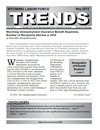Demographics of UI Claimants
More Males Continue to Receive Benefits than Females
Wyoming's labor market is driven primarily by industries such as natural resources & mining, construction, and leisure & hospitality due to the abundant mineral resources and popular tourist destinations within the state. Given the impact of these industries on the state's labor market, the demographic characteristics of those applying for and receiving unemployment benefits throughout the state are likely to vary.
Age Distribution
In first quarter 2008 (2008Q1), the average age of individuals receiving Unemployment Insurance (UI) benefits was 43 and by 2009Q2, the average age was 39.4 (see Figure 1). This indicates that as the economic downturn progressed from 2008Q4 to 2009Q4, younger workers were more likely to be affected by job loss. However, when the American Recovery & Reinvestment Act (ARRA, 2009) was enacted in February 2009, the average age of UI benefit recipients began to increase, peaking at 43.3 in 2012Q1.
Gender and Industry
The Great Recession affected the gender distribution of Wyoming's UI benefit recipients in different ways. In 2009Q1, 83.4% of those receiving a UI benefit were males. As discussed above, Wyoming's labor market is dominated by industries that tend to employ more males than females (such as construction and mining) and that are more seasonal (such as tourism).
Figure 2 (see page 10)shows both the gender differences and the seasonal effects in Wyoming's labor market. At the beginning of the Great Recession, men experienced more significant job losses than women, with women remaining steady throughout the entire timeline analyzed. Males also showed more seasonality in job losses than females. All major spikes in unemployment occurred after the summer months (third quarter) when certain industries were beginning to lay off employees.
From 2008 to 2012, 91.4% of individuals receiving a UI benefit and working in the construction industry were males (see Figure 3). In mining, 7,529 males received UI benefits, compared to 671 females. Only five industries saw a higher number of females receiving UI benefits than males: information, finance & insurance, educational services, health care & social assistance, and retail.
Accommodation & food services saw a near even number of males (5,735) and females (5,698) receiving UI benefits, which indicates that the numbers of males and females being laid off at the end of the tourist seasons were nearly identical.
Gender and County
The distribution of industries throughout Wyoming varies by region. There are regional pockets based on the location of mineral resources and tourist destinations. As seen in Figure 4, 76.4% of those receiving a UI benefit in Campbell County were males, compared to 54.1% in Niobrara County. Natrona and Laramie counties, Wyoming's two largest counties, were nearly even in the number of male UI recipients (70.8% and 70.4%, respectively).
The distribution across counties is also of note. The five counties with the highest percentage of males receiving UI benefits (Weston, Campbell, Lincoln, Johnson, and Crook counties; see Figure 5) are located within the regional pockets mentioned earlier.





